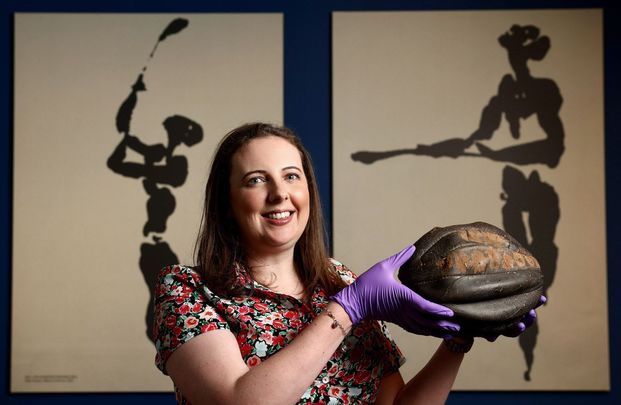"GAA: People, Objects & Stories", a new exhibition at the National Museum of Ireland, with some items over 500 years old, illustrates the influence of the GAA through the lens of social history, design and popular culture.
A multi-media exhibition, "GAA: People, Objects & Stories", that offers a new perspective on the GAA’s influence through the lens of social history, design and popular culture was launched by Minister of State for Sport and Physical Education, Thomas Byrne, at the National Museum of Ireland – Decorative Arts & History, Collins Barracks, in Dublin.
"GAA: People, Objects & Stories" is the creation of Dr. Siobhán Doyle, who is the NMI’s Curator of Glass, Ceramics and Asian Collections, and author of the critically acclaimed "A History of the GAA in 100 Objects".
While the GAA was formally established in 1884, the oldest objects on display as part of the exhibition are hurling balls made from matted cow hair with plaited horsehair dating back to the 15th century, found in bogland areas in County Kerry, Mayo and Limerick. Also on display is a rugby football used by the prisoners to play Gaelic football in Frongoch internment camp in Wales in 1916 and a hurl owned by Michael Collins.
Dr. Doyle said “All of the objects displayed as part of 'GAA: People, Objects & Stories' are accompanied by narratives that illustrate their significance in the history of the GAA, and in Ireland. Whether it’s the evolution of camogie uniforms for women or the rugby ball that was used in the Frongoch internment camp, they all tell a story of the GAA’s unique influence and role in Irish history right up to the current day. We are also inviting visitors to the exhibition to share their own GAA memories and images with us, so that they can be preserved for future generations.”
From the more recent past in the exhibition, is the baseball cap worn by one of the most successful managers in the history of hurling, Brian Cody, when he was Kilkenny's senior hurling manager from 1999 to 2022.
On three feature walls, visitors to the exhibition will also be able to see digital reproductions of artworks, newly commissioned design and photographs of Gaelic Games. How the GAA has influenced artists in the 20th century, the evolution of GAA jersey designs and the crossover in design between the Sam Maguire Cup and the Ardagh Chalice, are among the themes that are explored.
Visitors to the exhibition will be invited to respond to it, with their own GAA memories. These responses will be compiled and included in an exhibition archive that will preserve the stories for future generations.
Here are just some of the physical objects on exhibit:
- A 10-carat gold GAA medal made in New York, dating 1936, which is thought to have been presented to one of the players from the Cavan football team or Limerick hurling team that traveled to play in New York, in Yankee Stadium.
Gaelic games have been played in the USA since the late 1700s and have thrived in New York in particular, due to the strong community of Irish immigrants there. In May 1936, the Limerick hurlers and Cavan footballers traveled to the USA to play New York in both codes at Yankee Stadium. A medal from this match is featured in the exhibition.

The New York GAA medal from 1936 on display.
- A Medieval Mether, found at Corran in Co Armagh. The design of the iconic Liam MacCarthy cups is based on wooden methers, which are communal or "friendship" drinking vessels from the Celtic tradition.
- A handwoven tweed camogie dress worn by Maeve Gilroy in the 1960s during a successful decade for Antrim camogie. Maeve was awarded the Cú Chulann camogie award, in 1956, and went on to become a respected coach and referee.
- A medal presented to Austin Stack the Irish nationalist politician, militant republican and political prisoner, and celebrated athlete, when he was captain of the Kerry football team who won the Croke Cup competition in 1904-05. The Croke Cup Competition was one of the earliest inter-county tournaments in hurling and football.
- A hurling helmet worn by camogie player and former Wexford captain and now GAA analyst Ursula Jacob in the many All-Ireland finals in which she won medals from 2007 to 2020.
- A yellow slíotar used in the 2020 All-Ireland senior hurling final between Limerick and Tipperary, which marked the first game in which the yellow sliotar replaced the traditional white sliotar. The 2020 All-Ireland hurling final was also the first final to be played behind closed doors, due to the Covid-19 pandemic.




Comments